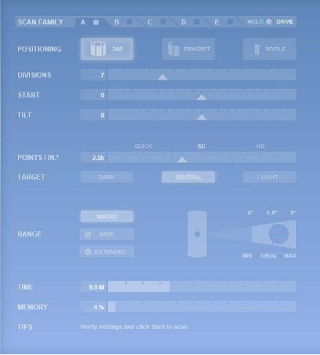
If not, click on the thumbnail to view the scan. A full view may also appear in the main window. The camera observes the variations in the reflected laser light and the software deduces from this the 3D form.Īfter a few minutes, the toolbar should say the scan is finished, and a thumbnail of the scanned surface should appear at the bottom left of the screen. The scanner will illuminate the object, taking a photo first, then scan a laser array over the object. For large objects you can scan different parts of the object and align them together later quite easily.

Extended mode is not available and requires extra payment (quite a lot I'm told).

check that the distance between scanner and object matches with the advice on screen near these options. Select either wide or macro scanning as appropriate. You can actually change this setting after scanning using Fuse/Regenerate.Īt the bottom of the scan page, the software indicates the estimated time that the scan will take in minutes, and the size of the scan in terms of memory (well, sort of). Low resolution scans are very crude, so more may be required to capture all the surfaces in any case. Select mid-SD resolution using the slider bar. This area controls the scope of the scan, either single, bracket (3 scans from different angles), 360 (several scans all around the object).ĭivisions determines the angles between scans in bracket and 360 modes - the greater the number of divisions, the smaller the angle between scans. Do not worry if your object does not fit in the preview at the appropriate distance - you can scan different parts of the object and align them together later quite easily.Īt the top of the scan window, select single scan. Watch this and manually adjust the position of the scanner so that the object is in the centre of the on screen preview. On screen you will see a live video image from the camera in the scanner. These screw into the holes at the corners of the turntable. There are various attachments for mounting more delicate objects onto the turntable. Place your object in the centre of the turntable. Using a ruler ensure that the centre of the turntable is 17" from the front of the scanner for a normal scan, or 11" for a macro (closeup) scan. The scanner will brightly illuminate the object for setting up. The bottom pane is a library of scans in the current file.Ĭlick the triangular 'Scan' button in the main toolbar to enter the scan window. The software environment is very simple: 3D geometry is shown in the main window, all the tools you need are accessed using the top toolbar, which also shows the status of the program. The blue light on the top of the scanner should illuminate.


Startup NextEngine HD from the desktop on the connected computer. Ensure that the scanner power and USB cables are plugged in at the back of the scanner, and the turntable is connected at the front of the scanner using the small network cable.


 0 kommentar(er)
0 kommentar(er)
